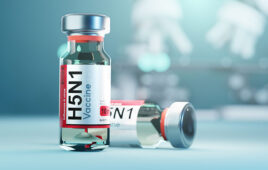 A new study by researchers at Brigham and Women’s Hospital (BWH) has found that for young, healthy women taking spironolactone to treat hormonal acne, frequent office visits and blood draws are an unnecessary health care expense. For the approximately 1,000 patients studied, blood tests to monitor potassium levels did not change the course of treatment, but the tests cumulatively totaled up to $80,000. The research team suggests that routine potassium monitoring should no longer be recommended for this patient population in order to improve the patient care experience, decrease unnecessary office visits and reduce health care spending. Their results appear online March 22 in JAMA Dermatology and are presented at the American Academy of Dermatology Conference March 23.
A new study by researchers at Brigham and Women’s Hospital (BWH) has found that for young, healthy women taking spironolactone to treat hormonal acne, frequent office visits and blood draws are an unnecessary health care expense. For the approximately 1,000 patients studied, blood tests to monitor potassium levels did not change the course of treatment, but the tests cumulatively totaled up to $80,000. The research team suggests that routine potassium monitoring should no longer be recommended for this patient population in order to improve the patient care experience, decrease unnecessary office visits and reduce health care spending. Their results appear online March 22 in JAMA Dermatology and are presented at the American Academy of Dermatology Conference March 23.“The need for testing may be a deterrent for both physicians and patients alike,” said Arash Mostaghimi, MD, MPA, director of Dermatology Inpatient Service at BWH and senior author of the study. “By demonstrating that for young, healthy women, it’s safe to give spironolactone without close potassium monitoring, we hope that more patients will be able to benefit from this medication.”
Spironolactone, a generic drug that’s been used in the clinic since 1959, is commonly prescribed for treating hormonal acne – acne that tends to affect the jaw line most commonly around the time of the month when a woman gets her period. The medication addresses the root cause of these acne outbreaks by affecting the production of hormones as well as the way that hormones bind to the skin.
Spironolactone’s primary use is as a diuretic and antihypertensive treatment for patients with heart failure and liver failure. In these patients, spironolactone has been associated with an increased risk of hyperkalemia – a dangerous elevation in potassium levels in the blood that can lead to abnormal heart rhythms. Based on this risk, the US Food and Drug Administration recommends frequent potassium monitoring in patients with heart failure taking spironolactone, but it’s been unclear if these guidelines should apply to healthy patients taking spironolactone for the treatment of acne, and, if so, how frequently such patients should have their potassium levels tested.
Mostaghimi and his colleagues evaluated clinical data from patients seen at Massachusetts General Hospital and Brigham and Women’s Hospital over a 15 year period. They calculated how frequently individual patients were tested and the rate of hyperkalemia.
“Our goal was to understand the current screening practices of physicians taking care of young, healthy women on spironolactone for acne and to determine what the usefulness of the test was – what we found was that doctors checked potassium levels at different frequencies, suggesting an ambivalence about the tests,” said Mostaghimi. “Of the more than 1,800 blood tests administered over that time period, we found no substantial problems or complications for these patients and no changes in their treatment based on what the tests showed.”
The researchers found just 13 cases of mild hyperkalemia. When tested a second time, half of these patients had normal potassium levels, and none of the patients showed any signs or symptoms of hyperkalemia.
The researchers note that a monthly dose of spironolactone costs $4.00; a serum electrolyte panel – frequently ordered along with potassium measurements – costs $43.51.
“There are two ways to think about cost,” said Mostaghimi. “The first is in terms of money spent – that’s almost $80,000 worth of testing done without any benefit in terms of patient treatment. But there are also the time and psychological costs of being monitored while taking a medication. There’s time and lost work productivity to consider too. We hope that by presenting these data, we will begin to create a standard of practice that best serves patients and helps physicians who may be ambivalent about recommending these tests for otherwise healthy patients.”
Source: Brigham and Women’s Hospital
Filed Under: Drug Discovery




